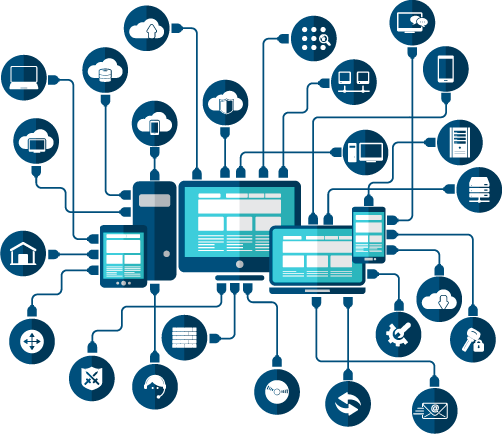Security Controls that secure everything from the perimeter to the desktop from the mobile devices to the cloud and datacenters.

Network Firewall
A firewall is a network security device that grants or rejects network access to traffic flows between an untrusted zone (e.g., the Internet) and a trusted zone (e.g., a private or corporate network).
It acts as the demarcation point or “traffic cop” in the network, as all communication should flow through it and it is where traffic is granted or rejected access.
They enforce access controls through a positive control model, which states that only traffic defined in the security policy is allowed onto the network; all other traffic is denied (known as “default deny”).
Advantages of using this technology: Monitors Traffic, Blocks Trojans, Stops Hackers, Stops Keyloggers


DNS/DHCP/IPAM (DDI)
DDI comprises the foundation of core network services that enables all communications over an IP-based network.
Top reasons why IT organizations should choose to automate their DNS, DHCP and
IP address management (DDI):
- Troubleshoot faster
- Do more with less
- Eliminate configuration errors
- Enhance security and compliance
- Prepare for DNSSEC and IPV6
MDM (Mobile Device Management)
Mobile device management (MDM) is a type of security software used by an IT department to monitor, manage and secure employees’ mobile devices that are deployed across multiple mobile service providers and across multiple mobile operating systems being used in the organization.
MDM is a way to ensure employees stay productive and do not breach corporate policies.
MDM implementations may be either on-premises or cloud-based.

All MDM products are built with an idea of Containerization. The MDM Container is secured using the latest cryptographic techniques. Corporate data such as email, documents, and enterprise applications are encrypted and processed inside the container. This ensures that corporate data is separated from user’s personal data on the device. Additionally, encryption for the entire device and/or SD Card can be enforced depending on MDM product capability.
This solution enable organization’s employees to have:
- Secure email
- Secure docs
- Secure browser
- Secure app catalog

IPDS / IPS
IPS is a control tool. It sits inline between two networks and control the traffic going through it. This means that the IPS is in the policy side of your security house. It’s going to implement or enforce a particular policy on what traffic is not allowed through.
The main reason to have an IPS is to block known attacks across a network. When there is a time window between when an exploit is announced and you have the time or opportunity to patch your systems, an IPS is an excellent way to quickly block known attacks, especially those using a common or well-known exploit tool.
Network intrusion detection and prevention systems (IDPS) are security tools used to spot intruders before they can do serious damage.
There are standalone physical and virtual appliances that inspect defined network traffic, either on-premises or in the cloud.
SDP (Software Defined Perimeter)
SDP (Software Defined Perimeter)
Software-Defined Perimeter is a security framework designed to provide on-demand, dynamically provisioned secure network segmentation.
A Software-Defined Perimeter is a network security model that dynamically creates one-to-one network connections between the user and the resources they access. Everything else is invisible including the system itself.


It ensures that all endpoints attempting to access a given infrastructure are authenticated and authorized prior to being able to access any resources on the network. All unauthorized network resources are made inaccessible. This not only applies the principle of least privilege to the network, it also reduces the attack surface area by hiding network resources from unauthorized or unauthenticated users.
SDP model works well across heterogeneous and hybrid environments.
SDPs lower the chances of successful network-based attacks such as denial-of-service attacks, man-in-the-middle attacks, server vulnerabilities and lateral movement attacks such as SQL injection or cross-site scripting

DDoS (distributed denial of service)
Any organization or individual having a web presence to maintain should be concerned about distributed denial of service (DDoS) attacks and can benefit from adopting a suitable protection solution.
DDoS attacks can cripple a
website or online application in minutes, resulting in lost revenues, reputation damage and reduced customer confidence.
When choosing a DDoS mitigation solution, you should make sure the solution adheres to the following fundamental guidelines:
- Transparent Mitigation
- Absorb Volumetric Network DDoS Attack
- Identify Sophisticated Application (Layer 7) DDoS Attacks
- Leave a Path to Redemption
- Preserve the User Experience
- Always On Protection
- Monitor Application and Network Traffic
Network DLP
Network data loss prevention is a technology for securing an organization’s network communications, including email, web applications, and traditional data transfer mechanisms like FTP.
Companies utilize network data loss prevention solutions in order to prevent loss of sensitive information via the network.
These solutions enable companies to encrypt data and block risky information flows appropriately in order to monitor and control the flow of data over their networks and to meet regulatory compliance.

It ensures that all endpoints attempting to access a given infrastructure are authenticated and authorized prior to being able to access any resources on the network. All unauthorized network resources are made inaccessible. This not only applies the principle of least privilege to the network, it also reduces the attack surface area by hiding network resources from unauthorized or unauthenticated users.
SDP model works well across heterogeneous and hybrid environments.
SDPs lower the chances of successful network-based attacks such as denial-of-service attacks, man-in-the-middle attacks, server vulnerabilities and lateral movement attacks such as SQL injection or cross-site scripting













